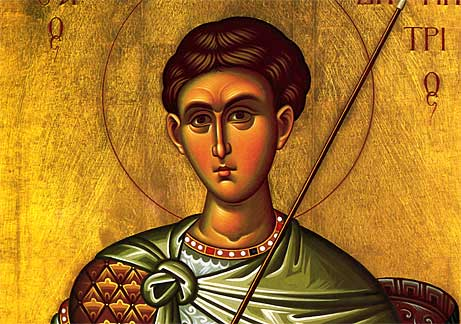
We will celebrate a Divine Liturgy on the eve of the feast day of St. Demetrios starting at 6:30pm.
Who was St. Demetrios?
The holy, glorious and right-victorious Great-martyr Demetrius of Thessaloniki the Myrrh-streamer (also Demetrios) is one of the most popular saints in the Orthodox world. He was martyred around the year 306 in Thessalonica.
Demetrius came from a noble family of the Roman province of Macedonia. Through this noble ancestry and through his own ability and virtue he rose to a high military position under Galerius Maximian, Caesar of the Eastern part of the Roman Empire (with Diocletian as the Augustus, or senior emperor). Despite this position in the still-pagan empire, he remained fervent in faith and works for Christ, encouraging many Christians to endure persecution and even bringing many pagans to the faith.
When Maximian returned from one of his campaigns to Thessaloniki, which he had made his capital, he had pagan games and sacrifices celebrated for his triumph. Demetrios was denounced by pagans who were envious of his success, and he was thrown into prison. While in prison he was visited by a young Christian named Nestor, who asked him for a blessing to engage in single combat with the giant Lyaios (or Lyaeus), who was posing as the champion of paganism. Demetrios gave his blessing and Nestor, against all odds, slew his opponent in the arena, as David had once defeated Goliath.
The enraged emperor, learning that this had occurred with Demetrios’s aid, first had Nestor beheaded outside the city and then had Demetrios impaled in prison. Later Demetrios’s servant Lupus was beheaded after using his master’s blood-stained tunic and signet ring to work many miracles. The Christians buried Demetrius and Nestor next together in the bath where Demetrius had been imprisoned. During the seventh century a miraculous flow of fragrant myrrh was found emanating from his tomb, giving rise to the appellation Mirovlitis, the Myrrh Gusher to his name. His tomb containing his relics is now in the crypt of the Church of St. Demetrios in Thessaloniki.
St. Demetrius is revered as the patron saint of Thessaloniki and is believed by the people as having intervened to save the city over the years from invading foreigners, from the Slavic nations, Bulgarians, Arabs, Saracens, and others. While well remembered in the Hellenic world, the memory of the Great Martyr Demetrius of Thessaloniki found an attachment in the Slavic, particularly the Russian, world from the times of the Russian Primary Chronicle.


